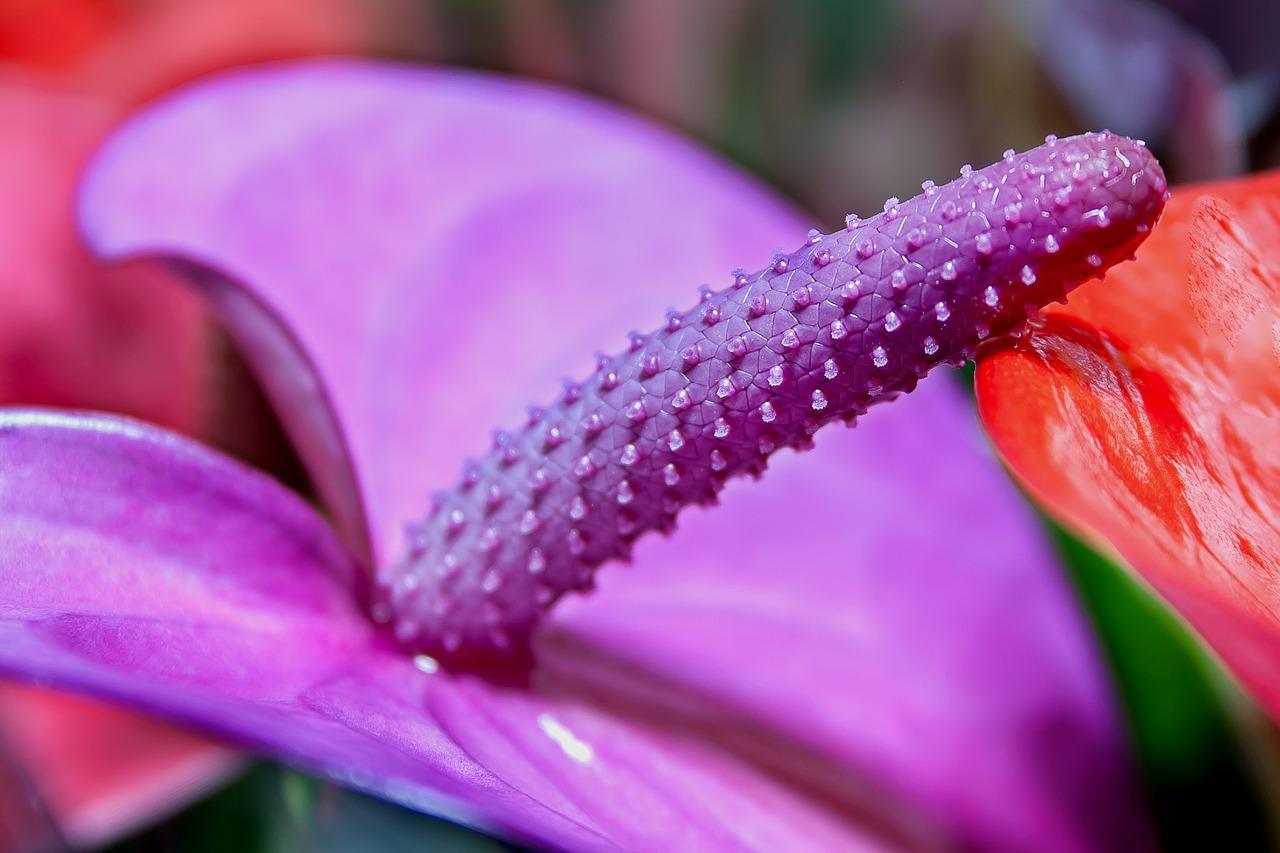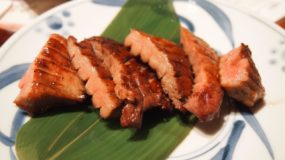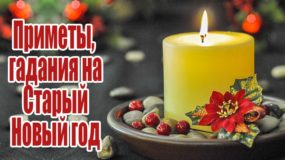Choose a houseplant that will fill the interior of the house with bright colors in the fall-winter season? Stop at Anthurium. Home care for this flower is not easy, but if done correctly, it blooms for almost a year.
I will examine in detail the intricacies of caring for this decorative exotic, and I will describe in detail the conditions in which to contain the flower, how to water, transplant and propagate. I will separately dwell on the problems that may arise when growing anthurium, and I will give effective ways to solve them. First, let's take a closer look at this flower.
Anthurium is an amazingly beautiful indoor plant, characterized by unmatched flowering. In nature, grows in Central and South America. The business card of anthurium is considered to be an unusual form of flowers. On a long stalk there is a veil of white, pink or red color, above which stands a straight or arc-shaped cob resembling a girl’s braid. Leaves are smooth and large.
Anthurium usually blooms in the summer, except for species that, in favorable conditions, throw flowers all year round. Flowering is long, often reaching one quarter.
Video description and useful tips
Home Care
Let's imagine that you returned home from the flower shop with the “new tenant” in your hands. Naturally, you are interested in how to care for anthurium.
I’ll warn you right away, Anthurium is rather capricious and poisonous. Improper handling is fraught with the appearance of diarrhea, vomiting, contact dermatitis and irritation of the mucous membranes. Therefore, keep the plant away from children and pets.
- Lighting. Anthurium does not like direct sunlight. Make sure that diffused light falls on the plant. Alternatively, keep in a shaded area. In winter, for the sake of flowering, highlight. The plant is shade tolerant, but in low light conditions it does not bloom.
- Temperature. The ideal temperature regime for anthurium ranges from 20-25 degrees. In winter, it is recommended to keep in a room with a temperature of 18 degrees. Remember, sudden changes in temperature and drafts adversely affect the anthurium.
- Watering. In the warm season, water the anthurium twice a week with warm water. In winter, watering intensity is halved. The flower is incredibly demanding on watering. He does not like either stagnation of water or dry land. Watering is not recommended with cold or lime water.
- Air humidity. In the tropics, air humidity is always high. To ensure such conditions in the apartment, spray the leaves regularly. The main thing is that moisture does not fall on the inflorescences, otherwise they will become stained and quickly fall off. At the base of the stem, put a piece of sphagnum, which will deliver moisture to the air roots and take care of their normal growth.
- Top dressing. At the time of growth and flowering, anthurium, like dracaenashould be fed a little.Perform the procedure twice a month using high-quality organic fertilizers or mineral solutions.
- Transfer. Experts recommend replanting young plants annually in early spring. Adults are transplanted every two years. Wide and shallow pots with good drainage are ideal for anthurium.
- Priming. The composition of the soil mixture should include humus, not sifted sheet soil, peat and sand. The ideal ratio is 4: 2: 2: 1, respectively. Pieces of broken brick with cones, moss and charcoal should be present in the substrate. The coarse fraction should be at least 15 percent of the volume of the soil mixture. Thanks to these components, the soil can easily pass water and air.
Types of Anthurium
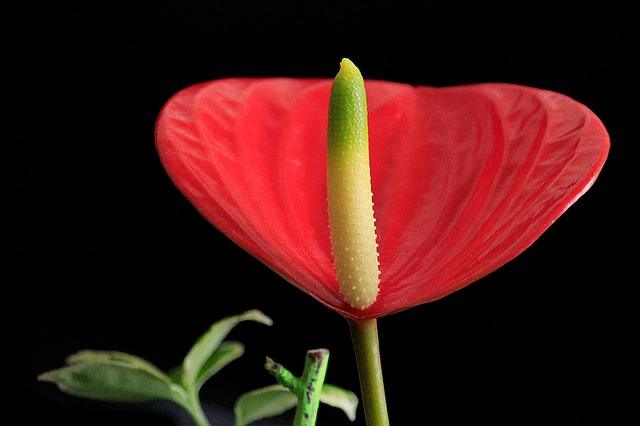
The considered indoor plant is ideal for decorating the interior. The flower will emphasize the harmony of decoration and conciseness of the office or living space. I will consider the types of anthurium that are best suited for growing at home.
- Scherzer. The most elegant look. It is characterized by a thin and twisty cob, which often folds into a ring. Varied color inflorescences. The color scheme begins with a yellow tint and ends in red. The list of distinctive features: unpretentiousness, massive, wide, oblong leaves with sharp tips.
- Andre. A variety of Anthurium Andre is larger than the previous species and grows to a meter high. The plant has heart-shaped leaves, an erect and slightly curved ear of yellow color. The bedspread is large, white, red, two-tone and even multi-color. Varieties with a red blanket are usually sold.
- Hybrid. Created by crossing species of Andre and Scherzer. The list of popular varieties of hybrid anthurium includes Alabama (red cover and yellow cob), Midori (emerald cover and yellowish cob), Monet (fancy color with green and pink strokes), Angel (snow-white cover and yellowish ear).
- Crystal. Incredibly decorative leaves - wide and heart-shaped, at the base one part of the leaf plate slightly goes into the second. Dark green leaves are covered with light green veins forming a mesh pattern. Inflorescence with a cob of a greenish-yellow hue, a drooping peduncle and a narrow greenish veil. The flower, due to its small size, is ideal for breeding in apartments and offices.
- Majestic. The pattern and texture of the leaves strongly resembles a crystal anthurium, but under optimal conditions it is characterized by a higher height and larger green leaves and a mesh pattern of light veins. The inflorescence resembles the previous view. Suitable for a greenhouse rather than a living room.
- Climbing. Oblong pointed leaflets. It is rare in flower shops. Allocate a variety with purple leaves. It adapts to the living conditions quite well. In winter, rest is necessary, providing for lowering the temperature and reducing watering.
- Elegant. This powerful plant has large dissected leaves with wavy tips. Due to the large inflorescence represented by a cherry ear and a yellowish veil, the species is considered the most beautiful. Acquiring is extremely problematic, but if possible, adapting to home conditions is not difficult.
- Hooker. Another decorative foliage variety differs from previous species in the absence of stems. The flower has wide emerald leaves collected in a socket. In residential conditions, rarely blooms. Thanks to the leaves and decent size it looks spectacular.
The considered types of anthurium are most suitable for home growing. They look great and perfect as a gift to your best friend. Keep this in mind.
Anthurium reproduction
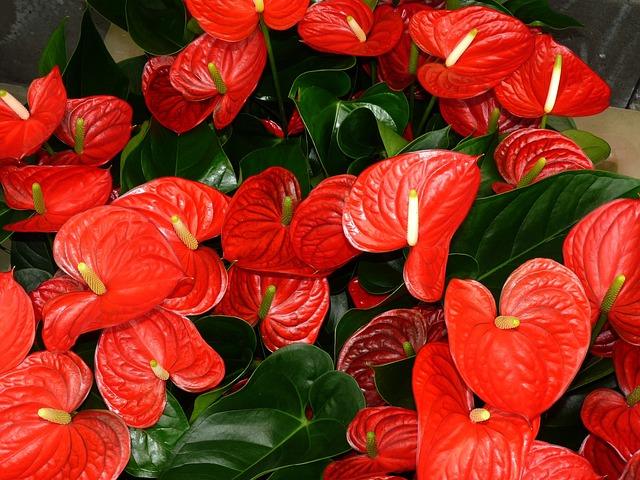
Anthurium, due to unusual flowering, is an object of admiration for gardeners. The plant is often called "masculine happiness."I will tell you 5 ways to breed anthurium.
Method one - propagation by apical cuttings
The most successful method of reproduction of anthurium involves the use of apical cuttings. It is better to carry out the procedure in late spring. During this period, the workpieces take root much faster. This method is used for propagation of dieffenbachia.
- Cut off the top of the shoot with a knife. The length of the handle is about 15 cm, with several leaves.
- In a plastic cup, make a drainage hole, fill with vermiculite, deepen the stalk by five centimeters, pour and moisten the leaves.
It is recommended to keep the container with the handle in a room with a temperature of about 25 degrees. Water the cuttings so that the crushed mineral does not dry out. For a month, the stalk will start up roots, after which it will be transplanted into a pot with an earthen mixture.
The second way - propagation by dividing the bush
This technique of home breeding Anthurium rejuvenates the plant. Perform the procedure better in the spring, at the time of transplantation.
- Remove the anthurium from the pot, carefully free the root system from the soil, with a knife, separate a couple of young shoots with roots and leaves.
- Plant the resulting blanks in separate pots to the previous depth, and return the main plant back.
To care for the updated plant, as for a full-fledged flower.
The third method - propagation by side shoots
This breeding technology resembles the previous method.
- From the adult flower, disconnect the side shoots with roots and leaves.
- Plant them in a pot with a prepared substrate in advance.
Water regularly, spray, periodically feed.
Fourth method - leaf propagation
In some cases, anthurium is propagated by rooting a leaf with a fragment of the stem. Place the leaf in boiled water and wait until the roots appear. Next, plant a young plant in a pot with suitable soil.
The fifth method - propagation by seeds
Florists rarely use seeds to propagate anthurium, since this is a complex and time-consuming process. To get a new flower, you need to plant the seeds in the ground and wait at least three months.
Transplant Secrets Video
You got acquainted with the technology of reproduction of anthurium. I recommend the first four ways. The fifth technique is mainly used by breeders in the process of breeding new varieties.
Breeding problems
Usually a flower rarely gets sick and endures the threat of insect damage without any problems. However, for certain reasons, there are times when pests attack it or catch a disease.
Common problems in breeding anthurium are represented by the absence of flowers, curling, yellowing or wilting of leaves, the appearance of spots on the trunk.
Disease
Anthurium has health problems when the owner violates the growing conditions or does not conduct insect prophylaxis. Diseases and pests are the worst enemies of Anthurium.
- Leaves rolled up - a protective reaction to exposure to excessively bright lighting. To solve the problem, rearrange the flower pot away from sunlight. After that, the plant will quickly unfold the leaves.
- The appearance of black spots on the flowers - the result of water ingress. To spray the anthurium, use a good spray, carry out the procedure as carefully as possible.
- If the stems rot - excessive watering. It is recommended to remove affected stems with putrefactive bacteria and stop soil moisture and spraying until recovery.
- Grayish plaque on the leaves - fungal disease "Gray rot." Put a flowerpot with a flower in a ventilated room, repair the damaged areas and treat with Topsin.
Pests
- Aphid. You can see aphids even with the naked eye. Usually it affects the delicate parts of the flower. To eliminate the problem, treat the anthurium with a special drug.
- Shield. Dark spots on the leaves are a sign of the appearance of a scale insect. When examining a sheet on the back, you can find a brown tubercle. Heals the flower by spraying with insecticides and rubbing with a solution of laundry soap.
- Spider mite. If the leaves turn yellow, curl and become stained, and the young leaves are degenerate, the anthurium has come into the view of the spider mite. To eliminate the pest, treat the plant with acaricide.
- Nematodes. A sign of nematodes is the appearance of thickenings and tubercles on the roots. It is impossible to get rid of the disease. Usually a plant with a pot is destroyed. If the anthurium grew in a ceramic container, it can be sterilized in the oven.
I have listed the most common diseases and pests to which a flower is exposed. We will consider other problems in detail.
Why do spots appear on leaves and trunk

The considered ornamental plant is not easy to grow. Improper care often causes illness. Let's understand why spots appear on the leaves and trunk.
- Waterlogging the soil. The main reason for the appearance of spots. Be sure to follow the rules of watering, otherwise it is problematic to restore the original appearance of the leaves and trunk after waterlogging.
- Incorrect substrate selection. When transplanting, you need to act carefully, trying not to damage the roots, and after the procedure, place the plant in a warm and bright place.
- Water. Stains appear when watering with cold or hard water.
- Aphid. Causes stains on leaf surfaces. To fix the problem, use the method or solution of tobacco described in the previous part. With a strong infection, Actellik or Karbofos will come to the rescue, in the case of croton.
- Septoria disease. In this disease, the affected leaves must be removed immediately, and to prevent the spread of the disease, the plant is treated with copper sulfate.
Try to properly care for the flower, and such problems simply will not appear.
Why do the leaves dry and turn yellow
A healthy plant blooms up to 3 months and constantly grows foliage.
- Incorrect lighting. The most common cause of drying and yellowing of leaves is improper lighting. To fix the problem, move the flower to a well-lit place. The main thing is that the direct rays of the sun do not fall.
- Low temperature. Usually a problem with drying out leaves occurs in the winter. At a temperature of 12 degrees, the leaves of anthurium turn yellow and are covered with brown spots. Solving the problem boils down to moving the flower to a warmer place.
- Excessive humidity. Fading and yellowing of leaves lead to root problems caused by excessive moisture. Pull the plant out of the pot and carefully inspect the roots. After removing the rotten elements, place the flower in fresh ground.
- Incorrect feeding. Excess or lack of fertilizer. If after feeding, the leaves turn yellow, pause during the procedure. If a uniform yellow spot appears - fertilize the flower.
Possible causes of yellowing and falling of leaves in anthurium are now well known. If these symptoms are found, proceed as recommended.
Why Anthurium does not bloom
There are frequent cases when the ornamental plant is capricious and refuses to bloom.
- Incorrect lighting. The plant feels great only in ambient light. Poor lighting, direct sunlight prevents flowering. Keep the flower in a shaded place and use a fluorescent lamp if there is a shortage of natural light.
- Low temperature. Anthurium throws flower buds only at a room temperature of at least 23 degrees. At a lower temperature, making it bloom is unrealistic.
- High temperature during wintering. Buds are tied during the dormant period. In this case, a temperature of around 16 degrees is required.
- Wrong watering. Waterlogging and drying out of the soil is one of the reasons why anthurium refuses to bloom. If the earth is moist and the flower does not absorb liquid, transplant it, taking care of normal drainage.
- Low humidity. Anthurium is a tropical plant. Consequently, he likes high humidity. Due to dry air, flowering is delayed.
- Old inflorescences do not fall. When the buds fade, the seed ripening process starts in them, which significantly weakens the flower. To keep the anthurium flowering, cut off the faded inflorescences.
I sincerely hope that with the help of these tips you will successfully overcome the difficulties in breeding this exotic plant and wait for the moment of flowering. Good luck in floriculture!

